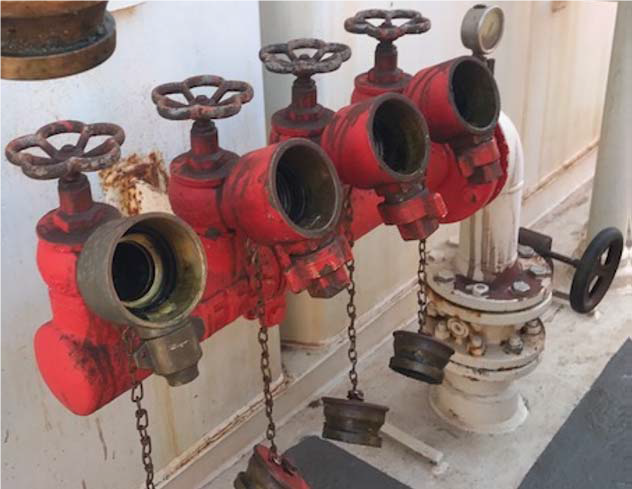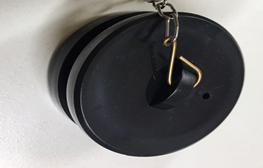Serious incident
A seafarer suffered serious injury while conducting routine maintenance work on part of a 13 bar high-pressure fire-fighting system on a fire-fighting tug.
Prior to the incident, maintenance on the manifold on the other side of the vessel had been completed without incident. As a result, it was assumed that the system was not pressurised.

Note: The hydrant in question is closest to the camera. Click on the image to make larger.
The seafarer was attempting to remove the brass blanking cap from a hydrant valve on a manifold of four valves fitted in parallel. The other three valves had been satisfactorily checked 10 minutes earlier.
The seafarer could not release the locking pawl by hand and, assuming that it was seized, utilised multigrips to free it. The line was under pressure and when the 600 gram blanking cap came free it was expelled under pressure and struck the seafarer in the face causing severe facial injuries.
Factors contributing to the incident
An investigation into the incident concluded that the following factors may have contributed:
- Inadequate safe work procedures for working on high pressure systems.
- Incomplete closure of both the butterfly isolating valve to the manifold and the hydrant valve allowed air to pass the valve seat and become trapped under pressure in the hydrant chamber.
- Lack of 3mm pressure relief holes in the hydrant blanking cap as specified in AS 2419.2-2009.
- Use of heavy brass hydrant blanking caps rather than lightweight alternatives.
- Turning directions for opening and closing of hydrant isolating valve were non-standard and opposite to that shown on the valve control.
- Isolating valve indicator was unclear and positioned out of operator’s line of sight.
This incident could have been prevented through effective controls, however, the provision of pressure relief and securing arrangements for the cap would have protected the seafarer where those controls were ineffective.
Recommendations
The Australian Maritime Safety Authority (AMSA) notes that SOLAS does not require pressure relief holes in blanking caps. However, AMSA strongly recommends that the requirement for 3mm pressure relief holes in hydrant blanking caps, as specified in AS 2419.2-2009—fire hydrant installations, be complied with.
Blanking caps are also available in a lightweight plastic composite material, which would significantly reduce impact forces should all other controls fail. AMSA supports the use of lightweight alternatives where appropriate.
AMSA also recommends the fitting of securing chains or wires to blanking caps as specified in AS 2419.2-2009—fire hydrant installations. This is designed to prevent the loss of the cap.

Note: the lightweight blanking cap shown above is fitted with a pressure relief hole and a securing chain.
Conclusion
Even where pressure relief arrangements are in place shipowners, operators, masters, and crew are reminded to exercise care when operating with, and working on, any fire-fighting systems. Perform the necessary checks described in the vessel’s safety management system to ensure that no part of the system is pressurised before working on it.
Gary Prosser
Deputy CEO
Australian Maritime Safety Authority
GPO Box 2181
CANBERRA ACT 2601